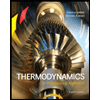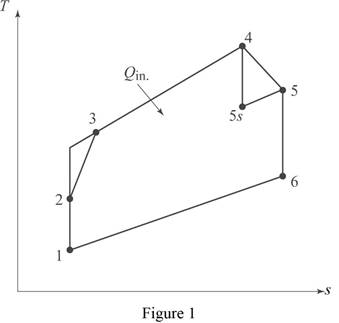
a)
The velocity of the exhaust gases
a)
Answer to Problem 137P
The velocity of the exhaust gases is
Explanation of Solution
Draw the

Consider, the pressure is
Consider that the aircraft is stationary, and the velocity of air moving towards the aircraft is
Diffuser (For process 1-2):
Write the expression for the energy balance equation for the diffuser.
Here, the energy entering the system is
Write the expression to calculate the temperature and pressure relation for the process 1-2.
Here, the specific heat ratio of air is k.
Compressor (For process 2-3)
Write the expression to calculate the pressure relation using the pressure ratio for the process 2-3.
Here, the pressure ratio is
Write the expression to calculate the temperature and pressure relation for the process 2-3s.
Write the expression for the efficiency of the compressor in the turbojet engine
Here, the specific heat of air at constant pressure is
Turbine (For process 4-5)
Write the expression for the temperature relation for the compressor and turbine.
Write the expression for the efficiency of the turbine in the turbojet engine
Write the expression to calculate the temperature and pressure relation for the process 4-5.
Nozzle (For process 5-6)
Write the expression to calculate the temperature and pressure relation for the isentropic process 4-5.
Write the expression for the energy balance equation for the nozzle.
Conclusion:
From Table A-2a, “Ideal-gas specific heats of various common gases”, obtain the following values of air at room temperature.
The rate of change in the energy of the system
Substitute
Here, the specific heat at constant pressure of air is
Substitute 0 for
Equation (XI).
Substitute 32 kPa for
Substitute 12 for
Substitute 280.0 K for
Substitute 0.80 for
Substitute 1100 K for
Substitute 0.85 for
Substitute 674.2 K for
Substitute 738.1 K for
The rate of change in the energy of the system
Substitute
Substitute 738.1 K for
Hence, the velocity of the exhaust gases is
b)
The propulsive power produced by the turbojet engine
b)
Answer to Problem 137P
The propulsive power produced by the turbojet engine is
Explanation of Solution
Write the expression to calculate the propulsive power produced by the turbojet engine
Here, the mass flow rate of air through the engine is
Conclusion:
Substitute
Hence, the propulsive power produced by the turbojet engine is
c)
The rate of fuel consumption.
c)
Answer to Problem 137P
The rate of fuel consumption is
Explanation of Solution
Write the expression to calculate the heating value of the fuel for the turbojet engine
Write the expression to calculate the mass flow rate of fuel for the turbojet engine
Here, the calorific value of the fuel is HV.
Conclusion:
Substitute
Substitute
Hence, the rate of fuel consumption is
Want to see more full solutions like this?
Chapter 9 Solutions
Thermodynamics: An Engineering Approach
- The turbines in steam power plants operate essentially under adiabatic conditions. A plant engineer suggests ending this practice. She proposes to run cooling water through the outer surface of the casing to cool the steam as it flows through the turbine. This way, she reasons, the entropy of the steam will decrease, the performance of the turbine will improve, and as a result the work output of the turbine will increase. How would you evaluate this proposal?arrow_forwardShow that the air standard efficiency of a gas turbine can be expressed in terms ofpressure ratio only.arrow_forwardWhat is the Carnot cycle?arrow_forward
- Consider an adiabatic turbine operating steadily. Does the work output of the turbine have to be equal to the decrease in the energy of the steam flowing through it?arrow_forwardConsider a facility that has a 130-kW compressor that runs 4400 h/yr at an average load factor of 0.6. Making reasonable assumptions and using unit costs for natural gas and electricity at your location, determine thepotential cost savings per year by switching to gas-drive enginesarrow_forwardExplain the thermodynamic processes involved in a multi-stage compression system, outlining the specific efficiency considerations at each stage, and how these processes differ from a single-stage compression system.arrow_forward
- A gas turbine that has a 0.75 efficiency compressor that compresses up to 0.5 MPa, a combustion chamber where fuel of 45 MJ/kg is burned that gives a temperature output of 900 K, a 0.85 efficiency turbine that is responsible for moving the compressor, and another 0.8 efficiency turbine that generates the necessary net power, which can be varied from 0 to 200 kW with a throttle valve between the turbines. Calculate:1. Compressor outlet temperature2. Pressure and outlet temperature of the first turbine.arrow_forwardA steam turbine is equipped to bleed 6 percent of the inlet steam for feedwater heating. It is operated with 4 MPa and 350°C steam at the inlet, a bleed pressure of 800 kPa, and an exhaust pressure of 30 kPa.arrow_forward1)Can the combined turbine-generator efficiency be greater than either the turbine efficiency or the generator efficiency? Explain 2) On a hot summer day, a student turns his fan on when he leaves his room in the morning. When he returns in the evening, will the room be warmer or cooler than the neighboring rooms? Why? Assume all the doors and windows are kept closed. 3) Water is being heated in a closed pan on top of a range while being stirred by a paddle wheel. During the process, 30 kJ of heat is transferred to the water, and 5 kJ of heat is lost to the surrounding air. The paddle-wheel work amounts to 500 N · m. Determine the final energy of the system if its initial energy is 10 kJ. 4) Consider a hooded electric open burner in an area where the unit costs of electricity and natural gas are $0.07/kWh and $1.20/therm, respectively (Noting that 1 therm = 29.3 kWh) . The efficiency of open burners can be taken to be 73 percent for electric burners and 38 percent for gas burners.…arrow_forward
- A plant engineer suggests ending this practice. She proposes to run cooling water through the outer surface of the casing to cool the steam as it flows through the turbine. This way, she reasons, the entropy of the steam will decrease, the performance of the turbine will improve, and as a result the work output of the turbine will increase. How would you evaluate this proposal?arrow_forwardConsider a gas turbine of 200 kJ/kg net work, operating under standard cold air assumptions. Determine the thermal efficiency, in %, of the turbine, if it has a regenerator with 90% efficiency.arrow_forwardA turbine generates 8000 kW at 40,000 kg/hr of steam and exhaust at 10 kPa with an enthalpy of 2510 kJ/kg. If the boiler pressure is 6 Mpa, determine the isentropic efficiency.arrow_forward
 Elements Of ElectromagneticsMechanical EngineeringISBN:9780190698614Author:Sadiku, Matthew N. O.Publisher:Oxford University Press
Elements Of ElectromagneticsMechanical EngineeringISBN:9780190698614Author:Sadiku, Matthew N. O.Publisher:Oxford University Press Mechanics of Materials (10th Edition)Mechanical EngineeringISBN:9780134319650Author:Russell C. HibbelerPublisher:PEARSON
Mechanics of Materials (10th Edition)Mechanical EngineeringISBN:9780134319650Author:Russell C. HibbelerPublisher:PEARSON Thermodynamics: An Engineering ApproachMechanical EngineeringISBN:9781259822674Author:Yunus A. Cengel Dr., Michael A. BolesPublisher:McGraw-Hill Education
Thermodynamics: An Engineering ApproachMechanical EngineeringISBN:9781259822674Author:Yunus A. Cengel Dr., Michael A. BolesPublisher:McGraw-Hill Education Control Systems EngineeringMechanical EngineeringISBN:9781118170519Author:Norman S. NisePublisher:WILEY
Control Systems EngineeringMechanical EngineeringISBN:9781118170519Author:Norman S. NisePublisher:WILEY Mechanics of Materials (MindTap Course List)Mechanical EngineeringISBN:9781337093347Author:Barry J. Goodno, James M. GerePublisher:Cengage Learning
Mechanics of Materials (MindTap Course List)Mechanical EngineeringISBN:9781337093347Author:Barry J. Goodno, James M. GerePublisher:Cengage Learning Engineering Mechanics: StaticsMechanical EngineeringISBN:9781118807330Author:James L. Meriam, L. G. Kraige, J. N. BoltonPublisher:WILEY
Engineering Mechanics: StaticsMechanical EngineeringISBN:9781118807330Author:James L. Meriam, L. G. Kraige, J. N. BoltonPublisher:WILEY





